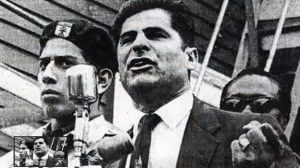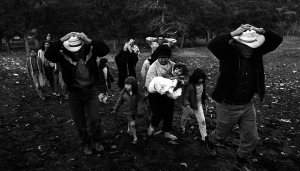
Reies López Tijerina, militant leader of an historic 1967 action for land rights of the Latino and Indigenous communities in New Mexico,died yesterday at the age of 88 in El Paso, Tx., where he lived in recent years.
The armed action that Tijerina led on June 5, 1967 was known as the “Tierra Amarilla Courthouse Raid,” and blazed in headlines of New Mexico and the U.S. press, in a struggle over lands stolen from the oppressed communities by the U.S. government and white landowners.
Tijerina’s organizing was a major inspiration for the new Chicano movement of the 1960s and 1970s, and exposed to the world the massive land theft in New Mexico that had so impoverished the Native and Latino people.

Tijerina preferred to identify as, and use the term “Indo-Hispano.” He, like many other leaders of the Chicano/Mexican struggle, marched shoulder to shoulder with the Native and Black liberation struggles, including the Black Panther Party and American Indian Movement. He and Martin Luther King, Jr. were allies.
As a fiery orator and tireless organizer, Tijerina rallied hundreds to the cause, to demand that the U.S. government honor the land grants. His most notable fight centered in northern Rio Arriba county, whose seat was Tierra Amarilla.
The lands in question — especially in the vast region of New Mexico — had been deeded by Spain to the Spanish settlers and Indigenous population by titles known as land grants, for those who farmed the land and created the irrigation systems, so necessary in the arid climate.
For many centuries before Europeans arrived, all land was communal. In the Spanish conquest, a pre-capitalist mode of production prevailed, with land tenure based on the land grants, which retained the collective use of land and sharing of common pastures. The many Pueblo Indian communities continued to resist colonization and assimilation, but subsistence agriculture was the norm in all the communities.
After Mexico’s independence from Spain in 1821, the land grants were still in force.
From 1846 to 1848 the United States launched a war of aggression against Mexico, stealing over 500,000 square miles, half of Mexico’s territory — now New Mexico, Arizona, Nevada, California, Utah and part of Colorado. White settlers in Texas had already declared a republic in 1836, and joined the United States in 1845.
Land and language rights of the people were supposedly guaranteed in perpetuity in the 1848 “Guadalupe-Hidalgo” peace treaty between Mexico and the United States. But like all treaties made with Native nations from east to west, it was soon tossed aside.
The U.S. conquest of the west brought the imposition of its rapidly developing capitalist system, in which land was a prime commodity. The genocidal war against Native people intensified, and massive land monopolization was soon underway.
In the late 1800s, the oppressed people of New Mexico became dispossessed of their land by wholesale destruction of land grants by white land speculators, the U.S. government, railroad companies and ranchers.
In just one example, Thomas B. Catron, a former Confederate general in the Civil War, moved to the New Mexico territory, became a lawyer and soon acquired a controlling interest or outright ownership of 34 land-grants totaling 3 million acres.
Catron was a member of the notorious Santa Fe Ring, the largest land speculators’ gang in New Mexico, which also conspired against the Indian pueblos. With New Mexico’s admittance as a state in 1912, he became a U.S. Senator. Catron County is named after him.
The policy of outright robbery and extreme corruption drove the masses of people into extreme poverty, illiteracy, racism and isolation. Yet, the peoples retained their culture, sense of history and claim to the land.
Tijerina, the son of migrant farmworkers in Texas, began organizing communities in Texas and Arizona. Although lacking formal education, he researched extensively the history of the land, traveling to Mexico and Spain to learn the origin of the land grants.
Moving to New Mexico in 1960, he soon embarked on the crusade to vindicate Native/Chicano/Mexican people’s right to the land stolen from them.
In 1963, Tijerina formed the Alianza Federal de Mercedes, or Federal Alliance of Land Grants with a core of activists, many descendants of the original land grants. Soon hundreds of people joined. The widely-listened-to Spanish radio station in Albuquerque, KABQ, gave the Alianza a weekly show to explain their cause.
After appealing to U.S. presidents and politicians to no avail, after numerous court appeals were turned down, the Alianza launched dramatic actions to drive the point home.
On October 22, 1966, hundreds of Alianza members in 150 vehicles drove into Echo Amphitheatre Park. It used to be the land grant of San Joaquin del Rio de Chama of more than 300 families, but now was U.S. government property. After a stand-off, several Alianza members were arrested and charged with trespassing.
On June 6, 1967, when 11 Alianza members were suddenly arrested, Tijerina led a armed group to make a citizens’ arrest of District Attorney Alfonso Sanchez, who had waged a campaign against the Alianza. In the struggle that ensued, shots were fired, two police were injured and the Alianza members briefly took two hostages.
An immediate massive hunt by the state National Guard, state police and FBI was launched, with women, men and children rounded up. After several days Tijerina and his comrades surrendered. In the trial that followed, Tijerina represented himself. With a fiery self-defense, he was surprisingly acquitted.
But the authorities kept indicting him on old accusations, and he was convicted and served two years in prison.
The Tierra Amarilla action sent a shockwave throughout the establishment. It was portrayed as a dangerous threat to the social order. Tijerina and his followers were hounded and the authorities waged a racist and brutal repression against them, even before Tierra Amarilla.
But the struggle for land was no longer hidden in the past.
Tijerina and the Alianza became an inspiration for the Chicano movement, with many youth joining in this and numerous other struggles in the Southwest.
Armando Rendón, author of the book “Chicano Manifesto,” commenting on his passing, said: “Tijerina was very much a part of what became the Chicano movement. He was a good warrior for all Raza and he brought attention to a lot of major issues.”
Tijerina explained in his autobiography, “They Called Me King Tiger: My Struggle for the Land and Our Rights”:
“The Anglos themselves had brought the taking of the Tierra Amarilla courthouse upon their own heads. For the past nine years we had been writing to Washington, asking for justice and demanding an investigation. On December 12, 1959, we wrote to Dwight D. Eisenhower. In September 1963, we wrote to John F. Kennedy – on January 12, 1965, to L.B. Johnson. … We were citizens. They ate from our hands and labor, our taxes. They ran their affairs in Washington with our money. Yet, they treated us worse than dogs without an owner. We did not ask that they return the land to the heirs. We simply demanded that they investigate the title of San Joaquin. What was so difficult about this simple petition?”
At a time when racism and poverty were so profound in New Mexico, Tijerina led an historic struggle over the question of land and rights of the oppressed people of the state. Despite some contradictions and the eventual decline of his movement, Tijerina’s leadership awoke a consciousness and fight-back spirit that is still felt in New Mexico today.





